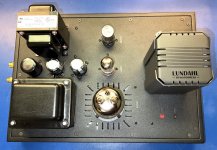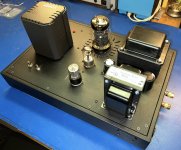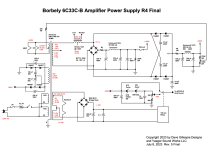I recently completed a pair of mono blocks with Erno Borbely's 6C33C-B SE triode amp, using power transformers from Kenwood receivers and output transformers from Lundahl. I started the project more than 20 years ago. 🙂
A friend is testing one of them for me. So far it has a great square wave and produces 12.5W output across the entire 20 Hz to 20 kHz band.
The power supply is a little funky so I have attached a schematic.
A friend is testing one of them for me. So far it has a great square wave and produces 12.5W output across the entire 20 Hz to 20 kHz band.
The power supply is a little funky so I have attached a schematic.
Attachments
Last edited:
So far it has a great square wave and produces 12.5W output across the entire 20 Hz to 20 kHz band.
Never got around to build anything with this very visually appealing tube. What does the distortion spectrum look like? The output impedance?
The square wave shape and power bandwidth in a non-nfb amp are entirely a function of the output transformer's quality.
Thanks for in including the original build article.Thanks for posting. Interesting negative bias supply scheme. Can you say something about it? Any ripple / noise measurements?
Thanks
Erno's original article posted below
The negative supply is a voltage quadrupler. Most designs allow the filament(s) to heat up for about 2 minutes before applying B+. The downside is that instantaneous B+ can give a pretty big "thump" on the output. So my friend (and guru!) Dave Gillespie suggested that the bias on the 6C33C-B be held too low for the tube to conduct (that's why I needed about -200V) until the two minute interval had passed, at which time it would be dropped to about -70V.
I haven't measured ripple (or noise) on the negative supply. For that matter, I haven't looked at it on a scope yet. But given the very low grid current, I doubt it would be very much. I'm busy at the moment but will eventually get back to you with a measurement.
My friend plans to measure distortion (it's off his bench for now). I have a distortion analyzer and can work on the other mono block in the meantime, time permitting.Never got around to build anything with this very visually appealing tube. What does the distortion spectrum look like? The output impedance?
The square wave shape and power bandwidth in a non-nfb amp are entirely a function of the output transformer's quality.
In this application, the Lundahl LL1627 has an 8 ohm output impedance, with a 650 ohm primary. The low impedance and low turns ratio contributes to the excellent square wave performance.
Note that Borbely's design does feature some NFB as well as a "pre-distortion" circuit to try to get the final THD number down.



